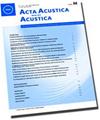用线性弹性方程求解板振动问题的节点不连续伽辽金法
Q1 Arts and Humanities
引用次数: 1
摘要
本文采用节点不连续伽辽金法对受迫板振动问题进行了数值求解。板模型为三维领域,及其振动是由线性弹性方程。节点DG方法discretises空间域和计算空间方程element-wise的衍生品,而时间是在使用龙格-库塔方法进行集成。该方法尤其感兴趣的,因为它是非常有利的进行计算的并行实现。给出了数值实现的几个方面,如板边界条件、点力激励和迎风数值通量。通过与经典板理论(CPT)和一阶剪切变形理论(FSDT)得到的精确位移量的比较,验证了不同边界条件和厚度的矩形混凝土板的数值结果。板厚的变化,以了解其影响,关于比较与CPT。数值解与FSDT有很好的一致性。与CPT的一致只发生在共振频率的前一对夫妇,随着板越来越薄。进一步将数值算例推广到l型混凝土板。然后将迁移率与CPT、FSDT和线性弹性方程得到的迁移率进行比较。本文章由计算机程序翻译,如有差异,请以英文原文为准。
Implementation of the Nodal Discontinuous Galerkin Method for the Plate Vibration Problem using Linear Elasticity Equations
This work presents a numerical solution of the forced plate vibration problem using the nodal discontinuous Galerkin (DG) method. The plate is modelled as a three-dimensional domain, and its vibration is governed by the linear elasticity equations. The nodal DG method discretises the
spatial domain and computes the spatial derivatives of the equations element-wise, while the time integration is conducted using the Runge-Kutta method. This method is in particular of interest as it is very favourable to carry out the computation by a parallel implementation. Several aspects
regarding the numerical implementation such as the plate boundary conditions, the point force excitation, and the upwind numerical flux are presented. The numerical results are validated for rectangular concrete plates with different sets of boundary conditions and thicknesses, by a comparison
with the exact mobilities that are derived from the classical plate theory (CPT) and the first order shear deformation theory (FSDT). The plate thickness is varied to understand its effect regarding the comparison with the CPT. An excellent agreement between the numerical solution and the
FSDT was found. The agreement with the CPT occurs only at the first couple of resonance frequencies, and as the plate is getting thinner. Furthermore, the numerical example is extended to an L-shaped concrete plate. The mobility is then compared with the mobilities obtained by the CPT, FSDT,
and linear elasticity equations.
求助全文
通过发布文献求助,成功后即可免费获取论文全文。
去求助
来源期刊
CiteScore
2.60
自引率
0.00%
发文量
0
审稿时长
6.8 months
期刊介绍:
Cessation. Acta Acustica united with Acustica (Acta Acust united Ac), was published together with the European Acoustics Association (EAA). It was an international, peer-reviewed journal on acoustics. It published original articles on all subjects in the field of acoustics, such as
• General Linear Acoustics, • Nonlinear Acoustics, Macrosonics, • Aeroacoustics, • Atmospheric Sound, • Underwater Sound, • Ultrasonics, • Physical Acoustics, • Structural Acoustics, • Noise Control, • Active Control, • Environmental Noise, • Building Acoustics, • Room Acoustics, • Acoustic Materials and Metamaterials, • Audio Signal Processing and Transducers, • Computational and Numerical Acoustics, • Hearing, Audiology and Psychoacoustics, • Speech,
• Musical Acoustics, • Virtual Acoustics, • Auditory Quality of Systems, • Animal Bioacoustics, • History of Acoustics.

 求助内容:
求助内容: 应助结果提醒方式:
应助结果提醒方式:


